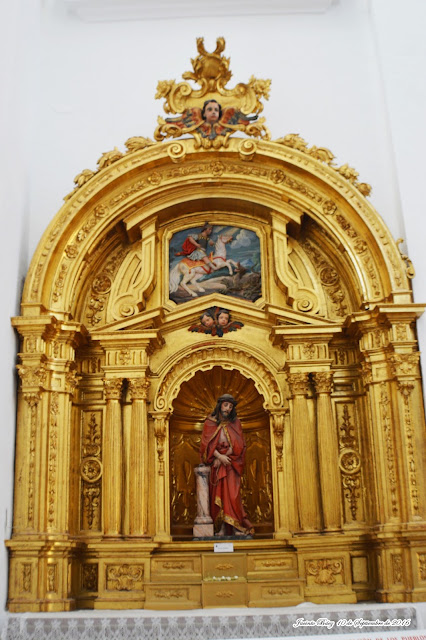 |
| La iglesia de San Francisco Javier, conocida también como iglesia de la Preciosa Sangre, es un templo cacereño de la ciudad monumental. Iglesia jesuita de estilo barroco construida en el siglo XVIII, se levantó, junto al convento anejo, con la fortuna de un miembro jesuita de la familia Figueroa, por ser éste el último eslabón de un mayorazgo que se extinguía. Las obras comenzaron en 1698 y concluyeron en 1755.
Pedro Sánchez Lobato, el arquitecto, la diseñó sobre una planta de cruz latina, con capillas laterales comunicadas con atajos y crucero cerrado por una cúpula con linterna. El fuerte desnivel que presenta la plaza sirve para que el conjunto parezca mucho más monumental, destacando las dos torres de la fachada, cuadradas de mampostería y sillería, rematadas por sendos chapiteles piramidales. Entre ambas torres, un arco de medio punto custodiado por dobles columnas sirve de puerta. Encima de él, una hornacina alberga una imagen de San Francisco Javier y el escudo de Castilla y León, rematado todo ello por un frontón partido. Esta fachada principal fue remodelada en 1992.
En el interior destaca el retablo mayor, ocupado por un lienzo del siglo XVIII con imágenes de San Francisco Javier.
Desde 1899 es custodiada por los padres misioneros de la Preciosa Sangre, por lo que también se conoce como iglesia de la Preciosa Sangre. Actualmente no se rinde culto en su interior. En la cripta se encuentra el Centro de Interpretación de la Semana Santa.
|
 | ||||||
Die Kirche von San Francisco Javier, auch als Kirche des Kostbaren Blutes bekannt ist, ist ein monumentaler Tempel cacereño Stadt. Jesuit Barockkirche im achtzehnten Jahrhundert erbaut, stand neben dem Kloster beigefügt, mit dem Vermögen eines Jesuiten Mitglied der Figueroa Familie, da dies das letzte Glied einer Erstgeburt ist, die ausgelöscht wurde. Die Arbeiten begannen im Jahre 1698 und im Jahre 1755 abgeschlossen. Pedro Sanchez Lobato, der Architekt, entwarf es auf einem lateinischen Kreuzes, mit Seitenkapellen kommuniziert mit Verknüpfungen und geschlossen von einer Kuppel mit Laterne Kreuzfahrt. Der Steilhang, die den Platz präsentiert dient der Satz viel monumentaler aussehen, markieren die beiden Türme der Fassade, Mauerwerk und Quadern Platz, gekrönt von zwei Pyramiden Türmchen. Zwischen den beiden Türmen, dient als Tür Rundbogen durch Doppelsäulen bewacht. Über ihm befindet sich eine Nische eine Statue des heiligen Franz Xaver und den Schild von Kastilien und Leon, die alle von einem Giebel gekrönt. Die Hauptfassade wurde 1992 umgebaut.
Innerhalb des Hauptaltarbild, das von einem achtzehnten Jahrhundert Leinwand mit Bildern von San Francisco Javier besetzt.
Seit 1899 wird er von den Missionaren vom Kostbaren Blut bewacht, die auch als Kirche des Kostbaren Blutes bekannt ist. Derzeit gibt es im Inneren verehrt. In der Krypta ist die Interpretation Center der Karwoche.
 | ||||||
L'église de San Francisco Javier, aussi connu comme l'église du Précieux-Sang, est une ville de temple cacereño monumental. Jésuite église baroque construit au XVIIIe siècle, se tenait à côté du couvent annexé, avec la fortune d'un membre jésuite de la famille Figueroa, comme cela est le dernier maillon d'une primogéniture qui a été éteint. Les travaux ont commencé en 1698 et a conclu en 1755. Pedro Sanchez Lobato, l'architecte, conçu sur une croix latine, avec des chapelles latérales ont communiqué avec des raccourcis et fermés par une coupole avec croisière lanterne. La pente raide qui présente le carré sert à l'ensemble un aspect plus monumental, mettant en évidence les deux tours de la façade, la maçonnerie et la pierre de taille carré, surmonté de deux flèches pyramidales. Entre les deux tours, arc en plein cintre gardée par des colonnes doubles sert de porte. Au-dessus de lui, une niche abrite une statue de saint François Xavier et le bouclier de Castille et Leon, le tout surmonté d'un fronton. La façade principale a été rénové en 1992.
A l'intérieur le retable principal, occupé par une toile du XVIIIe siècle avec des images de San Francisco Javier.
Depuis 1899, il est gardé par les missionnaires du Précieux-Sang, qui est également connu comme l'église du Précieux-Sang. Actuellement, il est adoré à l'intérieur. Dans la crypte est le centre de la Semaine Sainte d'interprétation.





















No hay comentarios:
Publicar un comentario